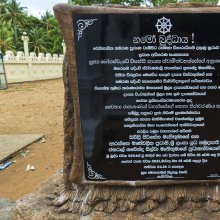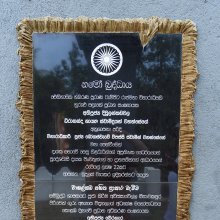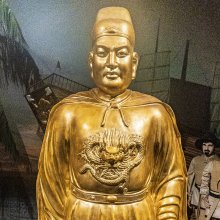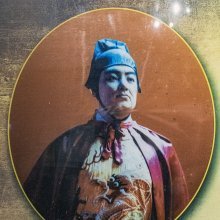Commander: 1 definition
Introduction:
Commander means something in Hinduism, Sanskrit. If you want to know the exact meaning, history, etymology or English translation of this term then check out the descriptions on this page. Add your comment or reference to a book if you want to contribute to this summary article.
Images (photo gallery)
(+2 more images available)
In Hinduism
Shilpashastra (iconography)
Source: Shodhganga: Elements of Art and Architecture in the Trtiyakhanda of the Visnudharmottarapurana (shilpa)The Commander refers to a certain class of personalities which follows specific guidelines in the tradition of ancient Indian Painting (citra), according to the Viṣṇudharmottarapurāṇa, an ancient Sanskrit text which (being encyclopedic in nature) deals with a variety of cultural topics such as arts, architecture, music, grammar and astronomy.—In the Viṣṇudharmottarapurāṇa, the rules of Painting of different classes have been elaborately discussed. The picture of the commander should be very graceful having a big head, wide chest, big nose, prominent chin, huge shoulders, clear hands and neck, forehead with three layers and great waist and his sight should be as sharp as an eagle. So, from the description of the Viṣṇudharmottarapurāṇa regarding the portrait of a commander, it can be assumed that, the body structure of a commander is quite hard and broad which resembles the physical description of the commander depicted in the Kādambarī.

Shilpashastra (शिल्पशास्त्र, śilpaśāstra) represents the ancient Indian science (shastra) of creative arts (shilpa) such as sculpture, iconography and painting. Closely related to Vastushastra (architecture), they often share the same literature.
See also (Relevant definitions)
Query error!
Full-text (+590): Senapati, Baladhyaksha, Sahasrin, Anji, Sainyadhyaksha, Nayaka, Camupati, Adeshin, Adeshtri, Camunatha, Jnapaka, Senani, Pranayaka, Dashadhipati, Senadhyaksha, Risaladara, Parshnigraha, Dalapati, Bakshi, Pagedara.
Relevant text
Search found 188 books and stories containing Commander; (plurals include: Commanders). You can also click to the full overview containing English textual excerpts. Below are direct links for the most relevant articles:
Nitiprakasika (Critical Analysis) (by S. Anusha)
Army Personnel < [Chapter 5]
Sarga VI: Senānayana-kathana (111 Verses) < [Chapter 2]
War Finance (Awards and Rewards) < [Chapter 5]
Yavanajataka by Sphujidhvaja [Sanskrit/English] (by Michael D Neely)
Verse 4.2 < [Chapter 4 - The Rule of the Objects of the Zodiac Signs and Planets]
Manasara (English translation) (by Prasanna Kumar Acharya)
The Religion and Philosophy of Tevaram (Thevaram) (by M. A. Dorai Rangaswamy)
Nayanar 12: Manakanchara (Manakkancarar) < [Volume 4.1.1 - A comparative study of the Shaivite saints the Thiruthondathogai]
Nayanar 9: Yenathinathar (Enatinata) < [Volume 4.1.1 - A comparative study of the Shaivite saints the Thiruthondathogai]
Nayanar 8: Eripatha (Eripattar) < [Volume 4.1.1 - A comparative study of the Shaivite saints the Thiruthondathogai]
Mahabharata (English) (by Kisari Mohan Ganguli)
Section CLVII < [Bhagavat-Yana Parva]
Section CLXVII < [Ghatotkacha-badha Parva]
Section XVI < [Arjunabhigamana Parva]
Puranic encyclopaedia (by Vettam Mani)





